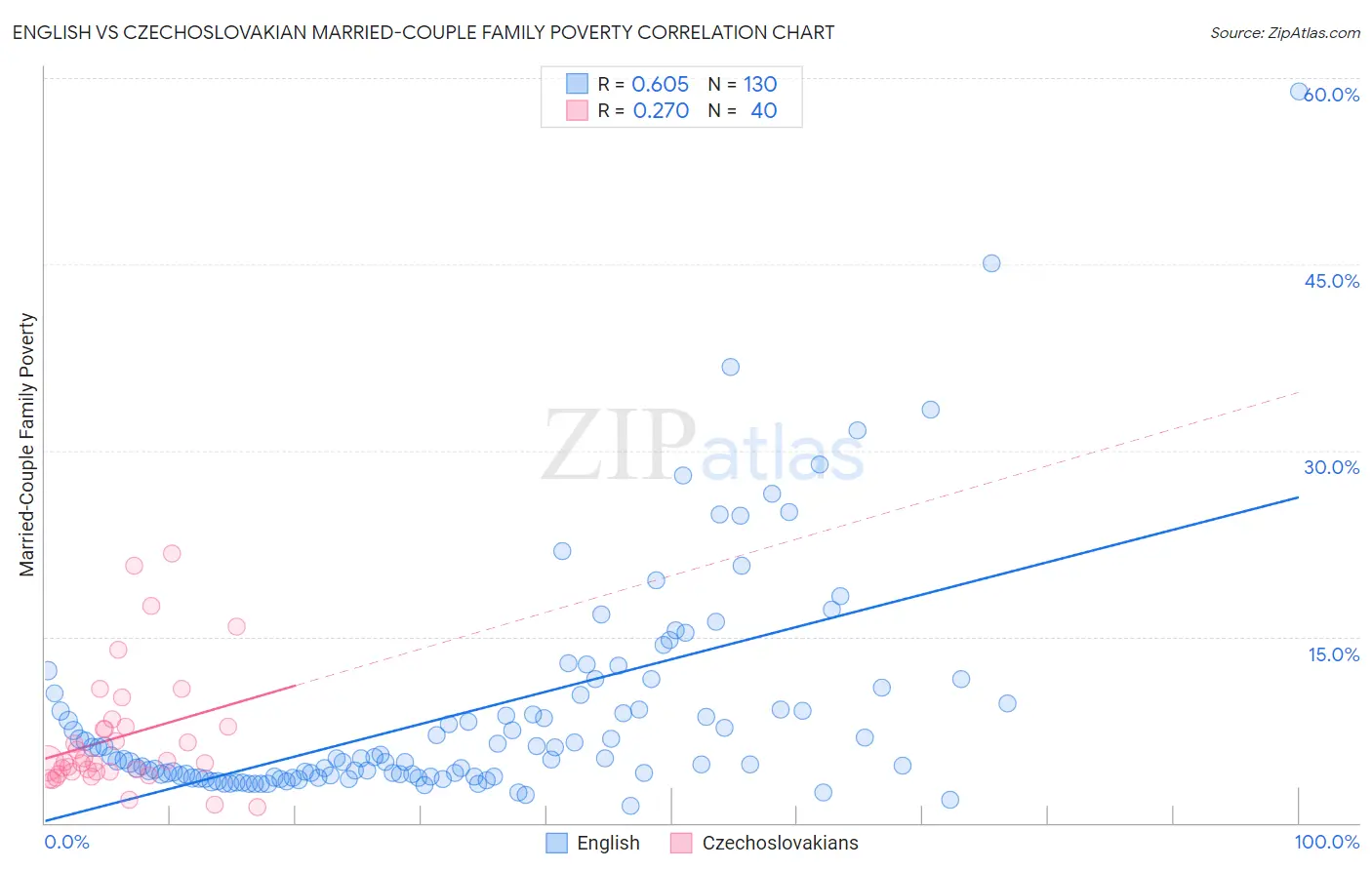English vs Czechoslovakian Married-Couple Family Poverty
COMPARE
English
Czechoslovakian
Married-Couple Family Poverty
Married-Couple Family Poverty Comparison
English
Czechoslovakians
4.2%
MARRIED-COUPLE FAMILY POVERTY
99.9/ 100
METRIC RATING
36th/ 347
METRIC RANK
4.4%
MARRIED-COUPLE FAMILY POVERTY
99.7/ 100
METRIC RATING
58th/ 347
METRIC RANK
English vs Czechoslovakian Married-Couple Family Poverty Correlation Chart
The statistical analysis conducted on geographies consisting of 562,851,245 people shows a significant positive correlation between the proportion of English and poverty level among married-couple families in the United States with a correlation coefficient (R) of 0.605 and weighted average of 4.2%. Similarly, the statistical analysis conducted on geographies consisting of 364,959,932 people shows a weak positive correlation between the proportion of Czechoslovakians and poverty level among married-couple families in the United States with a correlation coefficient (R) of 0.270 and weighted average of 4.4%, a difference of 3.0%.

Married-Couple Family Poverty Correlation Summary
| Measurement | English | Czechoslovakian |
| Minimum | 1.4% | 1.3% |
| Maximum | 58.9% | 21.7% |
| Range | 57.6% | 20.4% |
| Mean | 8.9% | 6.9% |
| Median | 5.2% | 4.9% |
| Interquartile 25% (IQ1) | 3.7% | 4.2% |
| Interquartile 75% (IQ3) | 9.6% | 7.7% |
| Interquartile Range (IQR) | 5.9% | 3.6% |
| Standard Deviation (Sample) | 9.0% | 4.9% |
| Standard Deviation (Population) | 8.9% | 4.8% |
Similar Demographics by Married-Couple Family Poverty
Demographics Similar to English by Married-Couple Family Poverty
In terms of married-couple family poverty, the demographic groups most similar to English are European (4.2%, a difference of 0.030%), Iranian (4.2%, a difference of 0.070%), Belgian (4.2%, a difference of 0.19%), Immigrants from Northern Europe (4.2%, a difference of 0.32%), and Dutch (4.2%, a difference of 0.60%).
| Demographics | Rating | Rank | Married-Couple Family Poverty |
| Immigrants | Scotland | 99.9 /100 | #29 | Exceptional 4.2% |
| Finns | 99.9 /100 | #30 | Exceptional 4.2% |
| Estonians | 99.9 /100 | #31 | Exceptional 4.2% |
| Greeks | 99.9 /100 | #32 | Exceptional 4.2% |
| Irish | 99.9 /100 | #33 | Exceptional 4.2% |
| Dutch | 99.9 /100 | #34 | Exceptional 4.2% |
| Europeans | 99.9 /100 | #35 | Exceptional 4.2% |
| English | 99.9 /100 | #36 | Exceptional 4.2% |
| Iranians | 99.9 /100 | #37 | Exceptional 4.2% |
| Belgians | 99.9 /100 | #38 | Exceptional 4.2% |
| Immigrants | Northern Europe | 99.8 /100 | #39 | Exceptional 4.2% |
| French Canadians | 99.8 /100 | #40 | Exceptional 4.2% |
| Northern Europeans | 99.8 /100 | #41 | Exceptional 4.3% |
| Scottish | 99.8 /100 | #42 | Exceptional 4.3% |
| Swiss | 99.8 /100 | #43 | Exceptional 4.3% |
Demographics Similar to Czechoslovakians by Married-Couple Family Poverty
In terms of married-couple family poverty, the demographic groups most similar to Czechoslovakians are Immigrants from Zimbabwe (4.3%, a difference of 0.090%), Immigrants from Netherlands (4.3%, a difference of 0.090%), French (4.3%, a difference of 0.24%), Austrian (4.3%, a difference of 0.27%), and Welsh (4.3%, a difference of 0.53%).
| Demographics | Rating | Rank | Married-Couple Family Poverty |
| Immigrants | Lithuania | 99.7 /100 | #51 | Exceptional 4.3% |
| Russians | 99.7 /100 | #52 | Exceptional 4.3% |
| Welsh | 99.7 /100 | #53 | Exceptional 4.3% |
| Austrians | 99.7 /100 | #54 | Exceptional 4.3% |
| French | 99.7 /100 | #55 | Exceptional 4.3% |
| Immigrants | Zimbabwe | 99.7 /100 | #56 | Exceptional 4.3% |
| Immigrants | Netherlands | 99.7 /100 | #57 | Exceptional 4.3% |
| Czechoslovakians | 99.7 /100 | #58 | Exceptional 4.4% |
| Immigrants | Sweden | 99.6 /100 | #59 | Exceptional 4.4% |
| Tlingit-Haida | 99.6 /100 | #60 | Exceptional 4.4% |
| Okinawans | 99.6 /100 | #61 | Exceptional 4.4% |
| Immigrants | Australia | 99.6 /100 | #62 | Exceptional 4.4% |
| Immigrants | Sri Lanka | 99.6 /100 | #63 | Exceptional 4.4% |
| Immigrants | Bulgaria | 99.5 /100 | #64 | Exceptional 4.4% |
| Macedonians | 99.4 /100 | #65 | Exceptional 4.4% |